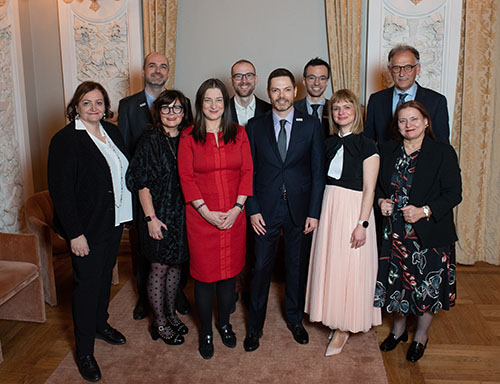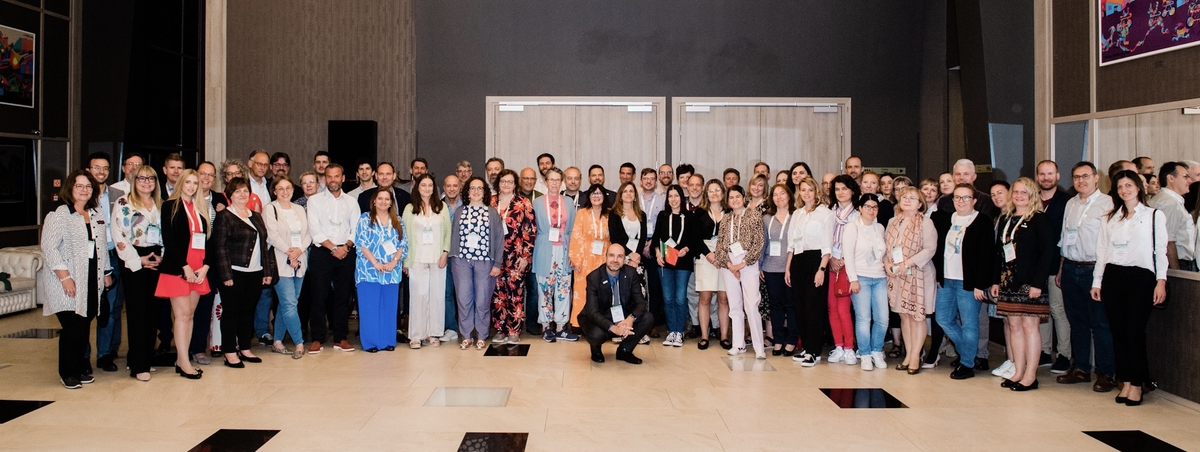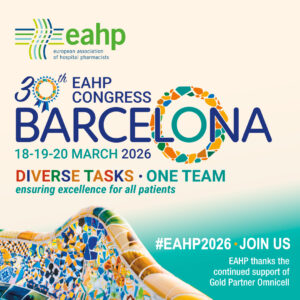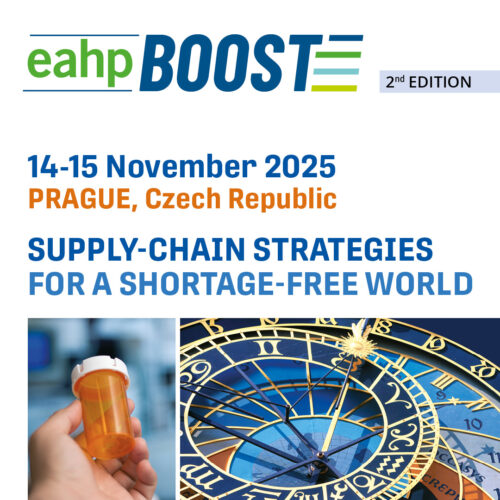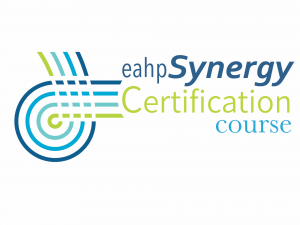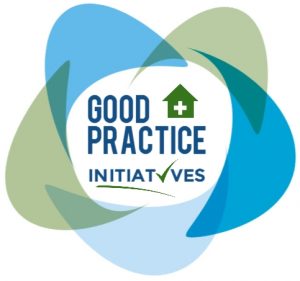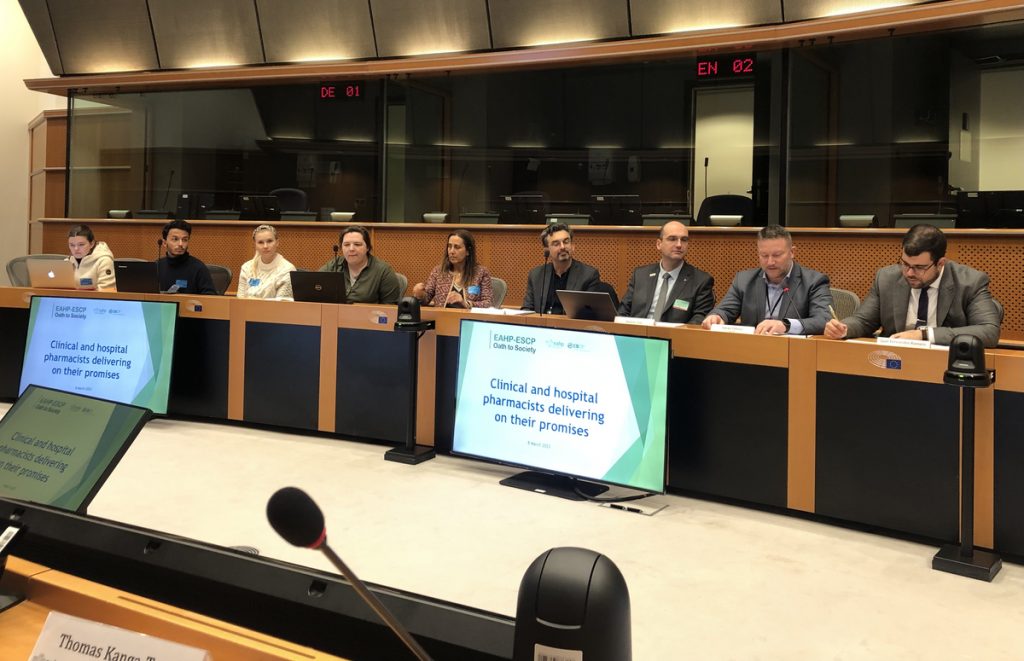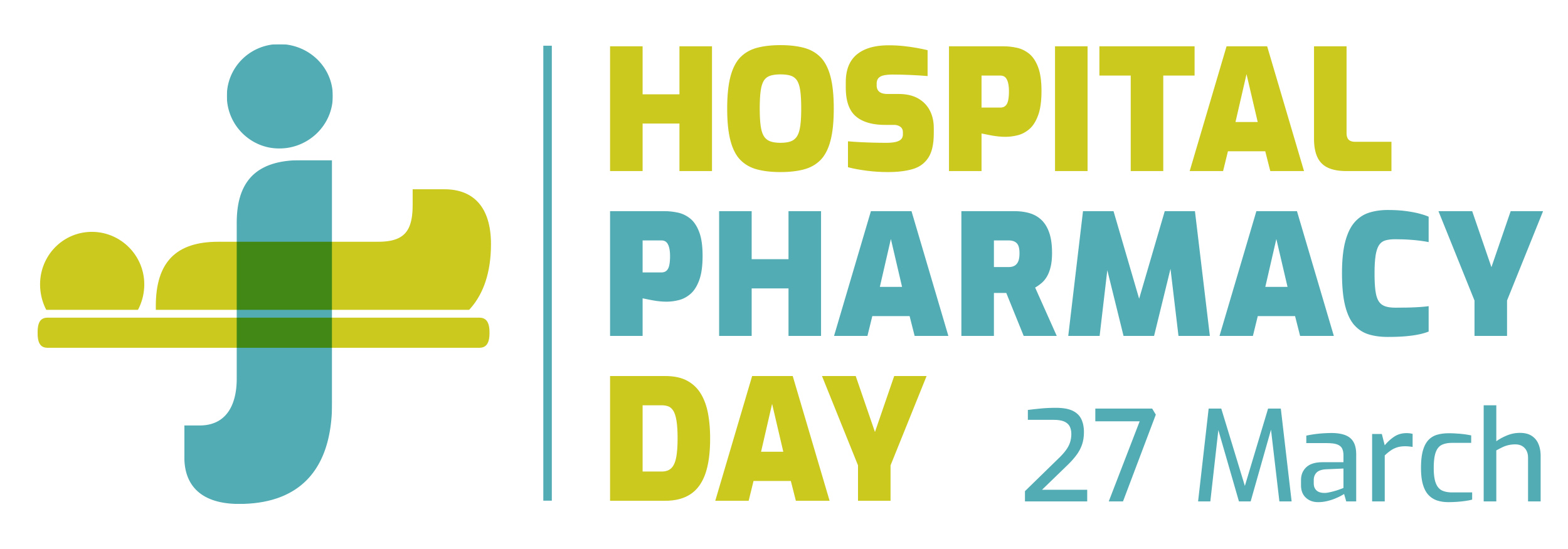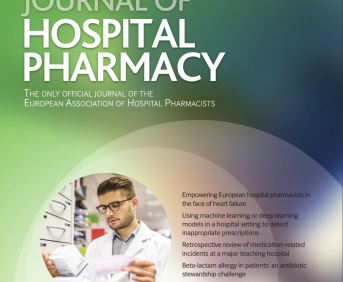INTEGRATING CLINICAL PHARMACY INTO DAILY WARD OPERATIONS: A TAILORED APPROACH ACROSS SPECIALTIES
Pdf

European Statement
Clinical Pharmacy Services
Author(s)
Adina Elihu, Claudia Wunder
Why was it done?
In Austria, there is growing recognition of the vital role clinical pharmacists play in healthcare teams. However, the current structure of the Austrian healthcare system does not adequately support the establishment of sufficient clinical pharmacist positions. Consequently, it is imperative to strategically integrate the limited available resources into patient-centered medication processes and fully harness their potential to enhance drug therapy safety.
The initial project was conducted in 2018/2019, and the present retrospective study was completed in 2022.
What was done?
This study explores the efficient integration of clinical pharmaceutical services across various medical disciplines, including both surgical and conservative fields. It specifically addresses how the integration of clinical pharmacy in surgical settings differs from that in conservative settings, and what success factors and obstacles need to be considered.
How was it done?
Through a retrospective analysis of outcomes from a comprehensive polypharmacy project, coupled with surveys of participating pharmacists and physicians, we delineate the procedures and methodologies essential for effective implementation.
What has been achieved?
It was demonstrated that a “one size fits all” approach, or a single process for all departments, is not practical. The study highlights specialty-specific considerations, such as the necessity for written communication on surgical wards and the inappropriateness and appropriateness of accompanying ward rounds in some cases.
Groundbreaking considerations for the approach were developed, including preparation, differences in approaches between surgical and conservative specialties, information sharing, communication pathways, necessities in the implementation phase and prerequisites for de-escalation.
The initiative paved the way for the introduction of electronic consultation systems to improve information transfer and documentation.
What next?
By identifying pitfalls and essential success factors, this initiative stands as a model for establishing clinical pharmacy services across various medical specialties, particularly in the context of limited personnel resources. It provides valuable guidance for colleagues involved in establishing these services.
IMPROVING ACCESS TO CARE: PATIENT PROFILES AND SATISFACTION IN HOME MEDICATION DELIVERY SERVICES
Pdf

European Statement
Clinical Pharmacy Services
Author(s)
Sánchez Cerviño, AC; Rivera Ruiz, María; Sanabrias Fernández de Sevilla, R; Menchén Viso, B; Folguera Olias, C; López Fernández, A; Pérez García, E; Martín Santamaría, A; Guerrero Feria, I; Sánchez Guerrero, A.
Why was it done?
Informed medication delivery at home, managed by the Hospital Pharmacy Service and facilitated by information technologies, aims to improve access to medication and enhance patients’ quality of life by avoiding unnecessary trips to the hospital. Although it incurs additional costs, it is essential to carefully select and prioritize candidates for this service.
What was done?
1. Analyze the profile of patients requesting medication delivery to establish priority criteria.
2. Evaluate patient satisfaction with this service in a tertiary care hospital.
How was it done?
An observational, retrospective, non-interventional, descriptive study was conducted on patients receiving medication delivery at home for two months upon their request.
Information was collected from electronic medical records and prescription systems, recording gender, age, underlying conditions, prescribed medications, and employment status.
Patient satisfaction with the service was also evaluated, and descriptive statistical analysis was performed.
What has been achieved?
During the study, medication was delivered to 443 patients (55.1% women) with a mean age of 57.3 years. Central nervous system disorders accounted for 16.0% of deliveries, followed by rheumatological diseases (15.1%) and oncohematological patients (9.3%).
Specifically, patients with multiple sclerosis represented the highest demand for this service (12.9%), due to mobility limitations. Additionally, medication was sent to patients with HIV (6.1%), attributable to stigma-related issues.
Analyzing patients’ employment status, 61.2% were pensioners (retired or with permanent disability).
Satisfaction assessment was conducted with 122 patients, who rated the service with an average score of 6.9 out of 10.
What next?
The results indicate that most patients utilizing informed medication delivery at home face difficulties traveling to the hospital. These patients often have disabilities, reduced mobility, or are unable to attend the hospital due to age, work-life balance, or family responsibilities, demonstrating an acceptable level of satisfaction. This patient profile should be prioritized for informed medication delivery services.
IMPLEMENTATION OF AN ATYPICAL MEDICATION ROOM TO OPTIMIZE MEDICATION MANAGEMENT AND REDUCE WASTE AT HERLEV GENTOFTE HOSPITAL, DENMARK
Pdf

European Statement
Clinical Pharmacy Services
Author(s)
Henrik Kjer, Christina Laustsen, Rasmus Riis, Caroline Rasmussen, Jeanette Bajrami, Christian Rubek, and Steffen Jørgensen
Why was it done?
An atypical medication room (AMR) was established at Herlev Gentofte Hospital, Denmark to centralize the storage and handling of medications not part of the standard assortment (i.e. atypical medication). The project aimed to improve the efficiency of medication management, reduce medication waste, and streamline workflows associated with the use of atypical medicines. To enhance the accuracy and efficiency of inventory control, the ScanPill technology was developed as a tool for digital tracking and updating of medication stock.
What was done?
Atypical medications are often stored across various departments with low turnover, leading to potential waste and time-consuming retrieval processes. Centralizing these medications in an AMR and using ScanPill aimed to reduce waste due to expiry, improve stock management, and simplify medication retrieval for healthcare professionals.
How was it done?
Atypical medications from multiple departments were collected and stored in the AMR. The ScanPill system was developed to facilitate the scanning of QR codes and barcodes on medication packaging, allowing for precise tracking of stock levels and easy updates to the atypical medication list. Staff were trained to use the AMR and ScanPill to ensure smooth transitions in retrieving, returning, and documenting atypical medicines. Regular inventory checks and updates were conducted to maintain an accurate database of available medications.
What has been achieved?
The AMR, supported by ScanPill, led to improved handling and management of atypical medications. The centralized storage reduced the need for duplicate stock across departments and enabled quicker access to necessary medications, reducing retrieval time and potential waste. The ScanPill technology improved inventory accuracy and streamlined the process of checking medication in and out, ensuring up-to-date records. Staff feedback has been positive, noting enhanced workflow efficiency and reduced medication waste.
What next?
Future steps include evaluating the economic impact of the AMR and its effectiveness in reducing medication waste. Efforts will be made to refine the use of ScanPill, enhance staff training, and explore potential applications of the AMR model across other departments. Continuous monitoring will ensure optimal performance and identify further areas for process improvement.
MANUAL COUNTING IN CONNECTION WITH THE MIXING OF INTRAVENOUS ANTIBIOTICS IS NOW BEING REPLACED BY A SOFTWARE ROBOT
Pdf

European Statement
Selection, Procurement and Distribution
Author(s)
Michelle Ann Matzen, Linda Jeffery, Mette Juul-Gregersen, Bente Jonassen, Lene Juhl Biltsted
Why was it done?
At the regional hospitals in Horsens and Randers, the pharmacy helps mix selected intravenous (IV) antibiotics for patients admitted to inpatient wards (piperacillin/tazobactam, cefuroxime, and cloxacillin).
The mixing takes place centrally and is then distributed to the relevant wards.
Our electronic prescribing system does not help us to identify which/how many patients require these antibiotics so the number of prescriptions for each ward was manually counted before the mixing process.
To reduce medication waste, the manual counting was done every morning and noon, with an estimated time consumption of about 1 hour per day per location.
The goal was to move away from manual counting and towards an automated solution.
What was done?
The pharmacy assists wards in mixing IV antibiotics. There was a desire to digitize and streamline the workflow through development of a software robot.
How was it done?
The pharmacy assembled a team from two locations and reached out to the region’s robotic process automation (RPA) developers.
The pharmacy set requirements and expectations for the RPA solution with the developers.
Throughout the development, the programming was revised and adjusted several times to obtain the most accurate prescription data.
To verify the robot’s counting, manual counts were conducted multiple times during the process, leading to adjustments in the robot’s programming.
The development of the RPA solution spanned 9 months.
What has been achieved?
The fully developed RPA solution is now used at both locations. A report is emailed twice a day, after which antibiotics are mixed and distributed to the relevant wards.
Benefits:
• Frees up time for other tasks
• Data is more up-to-date regarding changes in patients’ medications
• Medication waste is minimized
What next?
There are plans to create a similar setup for a central mixing unit at Aarhus University Hospital, where the RPA solution can be implemented from the start.
There is potential for the RPA solution to be used at other locations/departments, with different medications. For example, monitoring of inhalation preparations or anticoagulant medications.
IMPLEMENTATION OF A MULTIDISCIPLINARY PHARMACOKINETIC-PHARMACOGENETIC UNIT
Pdf

European Statement
Clinical Pharmacy Services
Author(s)
Jose Luis Sánchez Serrano, Ana Valladolid Walsh, Andrea Drodz Vergara, Carolina Andrés Fernández, Laura Navarro Casado
Why was it done?
Due to a reorganization of health professionals in our hospital, we identified an opportunity to include in our clinical services the preparation of pharmacokinetic reports for all drugs for which blood levels were carried out both at the hospital and external laboratories.
What was done?
We have implemented a multidisciplinary pharmacokinetic-pharmacogenetic unit with the Laboratory Department in our hospital. Until the end of 2023 we participated in the preparation of pharmacokinetic reports for a limited number of drugs in inpatients, basically in haematological and critical patientes. After this, we have included this clinical service for all drugs for which levels were carried out at the hospitalization and outpatient level.
How was it done?
The first step was to present a joint project to the hospital management to reorganize this activity and meet with medical departments to identify their needs and areas of improvement.
At the same time we acquired and implemented a specific software to assist us with the elaboration of recommendations.
We included training sessions in pharmacokinetics for pharmacists in the Pharmacy Department´s annual training program, in addition to offering an external course on Pharmacogenetics Course for staff pharmacists.
As to the clinical services offered, the project has gone through two stages:
• First stage (1 month duration): We reviewed all requests for drug levels obtained both from hospital and primary care level.
• Second stage (10 months duration): The pharmacist monitors all drug serum levels of narrow therapeutic margin and monoclonal antibodies both at the hospitalization and outpatient level. We have updated the available catalogue of drug serum concentrations tests in our center including Voriconazole, Linezolid, Ustekinumab, Adalimumab and Infliximab.
What has been achieved?
We have improved the whole process from ordering tests to sample extraction, serum level determination, and making recommendations in both inpatients and outpatients.
An average of about 160 pharmaceutical interventions per month are done with a 95% acceptability.
What next?
Our future objectives include updating the available pharmacogenetic testing in this unit in order to include recommendations based on test results.
LOCAL FORMULARY OF PALLIATIVE CARE IN THE ADULT PATIENT: A MULTIDISCIPLINARY APPROACH TO SYMPTOM RELIEF AND CONTINUITY OF CARE
Pdf

European Statement
Clinical Pharmacy Services
Author(s)
Francesca Baldi (1), Irene Bosoni (1), Sofia Filippini (1), Annamaria Valcavi (1), Gradellini Federica (1)
Alessia Rondini (3), Monica Salsi (3), Silvia Tanzi (2), Sara Alquati (2), Corrado Bacchi (3)
1. Pharmacy Department, Azienda USL-IRCCS, Reggio Emilia, Italy.
2. Palliative Care Unit, Azienda USL-IRCCS, Reggio Emilia, Italy.
3. Hospice Unit, Azienda USL-IRCCS, Reggio Emilia, Italy.
Why was it done?
Palliative care (PC) involves a network of hospitals and healthcare facilities supported by teams of nurses, specialists, general practitioners, and pharmacists. Off-label drugs are used to manage symptoms that do not respond to standard therapies, as permitted by law when no alternatives are available and under medical supervision. The National Health Service reimburses these drugs, but their use requires authorization based on proven safety and efficacy, potentially limiting patient access. Identifying essential drugs for symptom management is crucial to ensure a good quality of life.
What was done?
The AUSL of Reggio Emilia – IRCCS developed the “Local formulary of Palliative Care in Adult Patients” to support pharmacological management in PC. This formulary outlines key symptoms and provides evidence-based pharmacological options derived from scientific literature and clinical guidelines.
How was it done?
A multidisciplinary team of pharmacists, palliative care specialists, and nurses developed the formulary, defining essential treatments for palliative care across various local care settings. First published in 2019 and updated in 2022, the formulary specifies for each drug the indication, dosage, main side effects, and route of administration. Besides, it clarifies whether the use is in-label or off-label, based on the latest studies, accredited guidelines, and Italian legislation on off-label drug use. Off-label treatments are included to address multiple clinical needs when no approved therapeutic options exist, reducing empirical prescribing practices.
What has been achieved?
The formulary covers 16 symptoms, 99 drugs, and 30 active ingredients, ensuring continuity of care across the PC network. It allows PC specialists to prescribe listed medications, facilitating patient access to necessary therapies. This evidence-based system supports off-label use when approved options are unavailable, ensuring both patient safety and legal protection for healthcare providers. The tool is accessible to healthcare professionals through an electronic prescribing and administration system and in the company’s intranet section, promoting information sharing and continuity of care in hospital, community and home settings.
What next?
Clinical pharmacists play a critical role in ensuring appropriate prescribing and the proper implementation of the electronic system. Future steps include updating the formulary and expanding pharmacist training in palliative care
INCLUSION OF A CLINICAL PHARMACIST PHYSICALLY PRESENT AT THE EMERGENCY DEPARTMENT OF AN UNIVERSITY TERTIARY HOSPITAL
Pdf

European Statement
Clinical Pharmacy Services
Author(s)
JR ROMA, A RIZO, N POLA, B LOPEZ, A GARCIA, E BRAGULAT, M SANCHEZ, D SOY
Why was it done?
Several studies had been published claiming that the figure of a clinical pharmacist could improve the quality and safety of the medicines prescribed in the ED. However, little information has been published regarding its clinical impact when the pharmacist is physically present at the ED, which could enhance communication with clinicians and ED staff.
What was done?
A clinical pharmacist was included into the multidisciplinary team of the Emergency Department (ED).
How was it done?
The pharmacist performs their duties on-site from 8:00 a.m. to 11:00 a.m., Monday through Friday, joining the medical team located in the short stay unit (SSU) of the ED. The project was focused on validating and reconciling the medications of SSU patients who require short-term treatment, observation or reassessment of their initial ED treatment prior to discharge. Additional activities include logistical tasks, risk management and medication-related safety issues, with the identification of medication errors (MEs) during the pharmaceutical review. These errors are defined as any medication-related error, regardless of whether or not the patient experiences adverse effects.
What has been achieved?
During the first six months (December 2023–May 2024), 1904 clinical histories (patients) were reviewed (Mean day: 16 patients). MEs were found in 14.8% of the patients (282 patients), with a total of 338 MEs. Of these, 30.5% were reconciliation errors, 28.1% were overdosing errors, 15.1% were therapeutic duplicities and 8.9% were underdosing errors. Other identified MEs included: incorrect posology (3.8%), analytical value adjustments errors (3.0%), drug interactions (2.4%), incorrect duration (2.4%), adverse effects (2.1%), wrong administration route (1.8%), incorrect presentation (1.0%) and allergies (0.9%). The most common pharmacological class involved was antimicrobials (40.6%), followed by anticoagulants (13.2%), immunosuppressants (9.3%), and antihypertensives (7.8%).
What next?
Considering the overall satisfaction regarding the ED pharmacist figure in this setting, its work day in ED has been extended from 8:00 a.m. to 4:00 p.m. More research is needed in order to clarify if the role of the ED pharmacist working on-site at the ED can improve healthcare outcomes.
ENHANCING PROFESSIONALISM IN CLINICAL PHARMACIST SERVICE THROUGH DIGITAL COMMUNICATION
Pdf

European Statement
Clinical Pharmacy Services
Author(s)
Mia Pavelics Rehn
Trine Rune Høgh Andersen
Why was it done?
Clinical Pharmacists (CPs) in the Region Zealand Hospital Pharmacy (30 CPs) are scattered over great geographical distances on multiple hospital wards. When working with Clinical Pharmacist Services (CPS), usually just one CP is present per ward. All 30 CPs have different knowledge, seniority and specialization. To enhance the professionalism of the individual pharmacist on duty, digital communication such as chat functions are implemented for quick and easy intra-pharmacist consults.
What was done?
The ward physicians and nurses experience the combined specialty knowledge of 30 CPs from each CP when engaging CPS. This is highly relevant to maintain the position of having CPS through the hospital pharmacy instead of employing one individual CP directly on the ward, which has become more common over recent years.
How was it done?
To illuminate how the CPs from the hospital pharmacy share knowledge by using each other in their clinical operation, data was collected during three weeks of daily work. The CPs at 10 department wards registered each time they consulted a CP colleague. Furthermore, they recorded what type of communication they used (Microsoft Teams®, telephone or face-to-face) and what the inquiry was about. Written communication in Teams chat was saved for qualitative analysis.
What has been achieved?
The collected data illustrate the utilization of collective knowledge. In the three weeks 34 consults were made using primarily Microsoft teams. In 9 cases the contact was face-to-face and in 6 cases by phone. Most common was pharmacological discussion about specific cases during medication reviews (23), followed by questions about technical issues in the electronic patient record (11), general professional discussions (7) and consults about medication shortages and alternatives (8).
What next?
This initiative illustrates how using easy and available digital communication such as Teams chat functions across geographical distances will increase professionalism and harness the collective knowledge of many CPs working in collaboration for the benefit of improved CPS.
IMPLEMENTATION OF A SERUM MONITORING PROTOCOL FOR INFLIXIMAB IN PATIENTS WITH INFLAMMATORY BOWEL DISEASE
Pdf

European Statement
Clinical Pharmacy Services
Author(s)
Mafalda Cavalheiro 1
Maria José Rei 1
Ana Rita Silva 1
Patrícia Batalha Silva 1
Carolina Marques 1
Miriam Capoulas 1
1- Pharmacy Department, Hospital da Luz Lisboa, Portugal
Why was it done?
Low serum Infliximab are associated with lost of response and development of immunogenicity. Moreover, therapeutic levels without the control of the inflammatory activity may inform about the necessity of changing the therapeutic class. While monitoring serum levels in the absence of response is already well established, the proactive monitoring of serum levels at defined timings during the induction and maintenance phases of therapy is beginning to be recommended by several leading organizations.
What was done?
Establishment of a protocol for proactive serum monitoring of Infliximab in inflammatory bowel disease, to guide the interpretation of serum levels, optimize dosage and therapeutic response.
How was it done?
Implementation took place in several stages. 1) Theoretical and practical training culminating in the discussion and drafting of a technical guideline including a monitoring protocol with the Gastroenterology team. 2) Organization of the sample collection and analysis circuit. The analytical technique is a rapid test that allows the detection of infliximab levels and anti-infliximab antibodies. 3) Finally, dosage optimization (maintenance of the reference dosage or intensification – shortening the administration interval or increasing the dose) is carried out with the support of population pharmacokinetic models using the DoseMeRx software, interpreted in the context of the overall response assessment in conjunction with the clinical team. The main limitation identified had to do with awareness of the medical team to rational dosage adjustments based on the population model.
What has been achieved?
15 patients were included with a median age of 33 years; 11 of these were diagnosed with Ulcerative Colitis and 4 with Crohn’s Disease. A total of 24 tests were carried out (21 with a proactive strategy and three with a reactive strategy). Of the doses taken at week 6, 60% were below the reference range considered. The dosage regimen was intensified in 64% of the recommendations. Of the patients analyzed, 76% maintained their response, although the duration of treatment was less than a year in most cases.
What next?
The strategy of proactive monitoring and dose intensification may have contributed to achieving and maintaining the response to treatment with Infliximab, but the small number of patients and the duration of the analysis call for further analysis.
PHARMACEUTICAL CARE AND CHARACTERIZATION OF PATIENTS WAITLISTED FOR KIDNEY TRANSPLANTATION IN A THIRD LEVEL HOSPITAL
Pdf

European Statement
Clinical Pharmacy Services
Author(s)
M. López López-Cepero, H. Padilla Castaño, G. Arrufat Goterris, P. Clares Rubio, T. Bonnin Garau, A. Tugores Vázquez, C. Martorell Puigserver.
Why was it done?
A pharmaceutical care consultation (PCC) was implemented for patients waitlisted for kidney transplantation (PWKT). The PCC focuses on transplant medication education, accurate medication history, allergy review, adherence assessment and self-perception of therapeutic complexity.
What was done?
Medication non-adherence is the major issue in transplantation, and it is associated with increased risk rejection, allograft loss and patients’ death.
Medication education after the transplant was not enough. Intervening before the transplant enabled pharmacists to know the patients and develop an individualized therapeutic plan, so the patients arrive as prepared as possible on the day of the transplant.
How was it done?
PWKT were scheduled in PCC and the pharmacist review their medical history and prescriptions. Patients were contacted by telephone for an interview. A face-to-face consultation was also possible.
PCC evaluate:
1) Clinical variables: etiology of renal pathology, comorbidities, previous transplantation, current renal replacement therapy (TRR), CYP3A5 genotype.
2) Medication: allergies, current medication plan, adherence (Morisky-Green test and electronic prescription record), organization and self-perception complexity.
3) Pharmaceutical interventions (PI): deprescribe or update current treatment, reinforce adherence, propose Monitored Dosage System (MDS) or pillbox, immunosuppressants education, arrange for a second PCC, contact with their community pharmacy, send to Pharmacogenetics Committee.
What has been achieved?
The PCC was implemented in June 2024. Among the first 4 months, 28 of the 58 PWKT have been evaluated.
Analyzing the clinical variables has allowed us to describe PWKT profile. Knowing how patients manage medication, as well as the perception they have about the importance of their treatment, helps to create an action plan and better prepare the patient for the transplant.
Given that one third of the patients were non-adherent, most of the PI focused on adherence reinforce, including additional monitoring, propose MDS or pillbox pillbox and resolve medication doubts.
What next?
The next step is to include a PCC in our clinical practice and get to visit all PWKT before the transplant.
It is needed to evaluate the impacts of PCC and PI as regards clinical outcomes. Detecting improvement actions will be enriching for patients care.
The PCC can be extended to other types of solid organ transplants.
